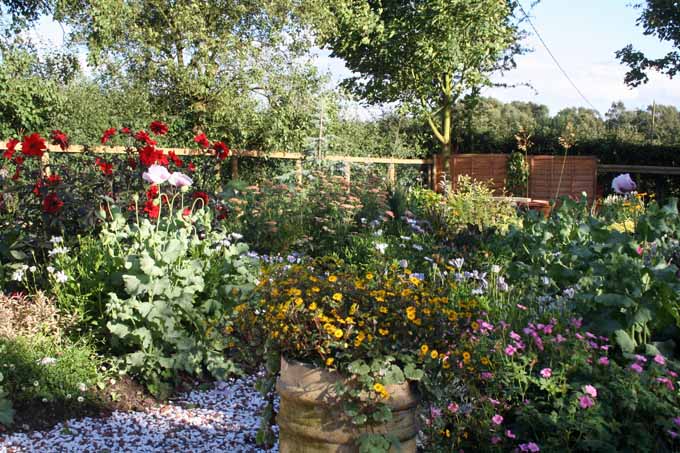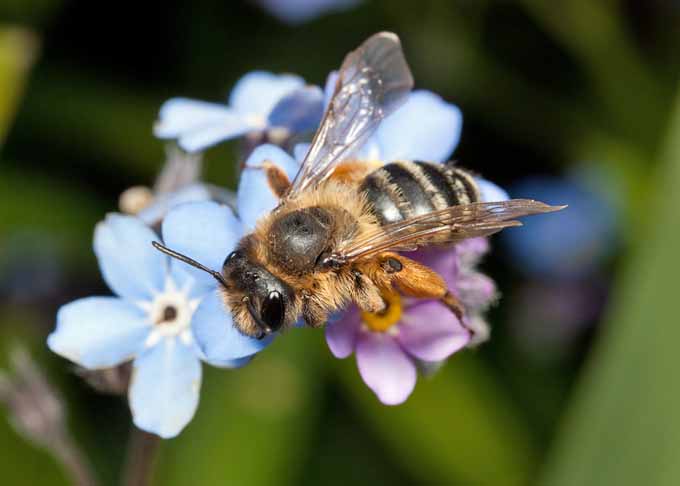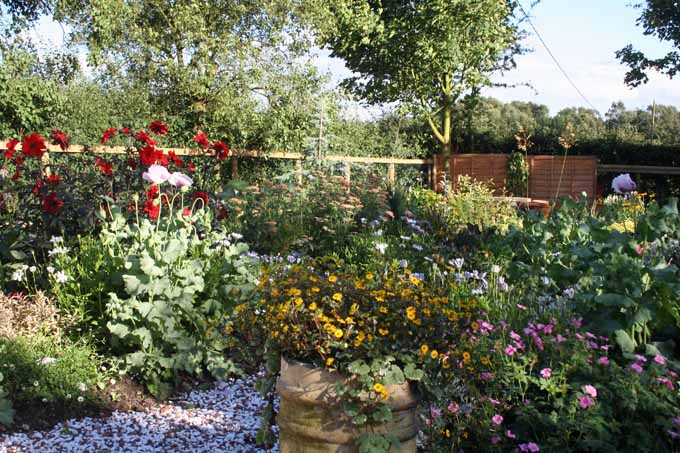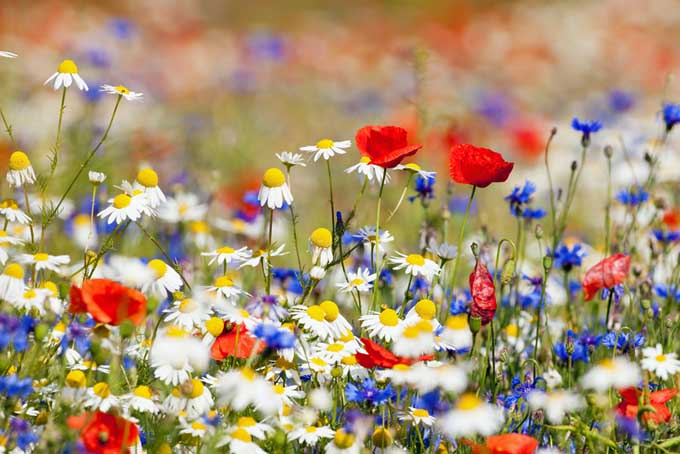We enjoy the beautiful flowers in our gardens but most of them need to be pollinated to survive. Without pollination, the plants would not be able to reproduce. The recent decline in the number of pollinators is a sad fact in itself. But did you know that bees actually pollinate about a sixth of the world’s crops, or around 400 of the agricultural plants we harvest? We link to vendors to help you find relevant products. If you buy from one of our links, we may earn a commission. This figure illuminates the true scale of this problem: It amounts to about a third of all the food we eat. Saying that there is a problem here is an understatement. But there are things that you can do to help. Here’s what’s to come:
Hardworking Helpers
There are about 25,000 species of bee in the world, and they all contribute to pollination in some way. This process involves the transfer of pollen from the male part of the plant, the anther, to the female part, or stigma, of another. The stigma then produces the seeds, fruits and nuts that we use for food. Features of their anatomy enable our buzzing friends to pollinate. The little pockets and hairs on their legs brush against the pollen, which clings to them as they explore the flowers. That pollen is then taken to another flower, as the bee looks for more nectar. Tending to stay with one type of flowering plant at a time makes this process more efficient. Rather than visiting a variety of blooms and wasting pollen on species that cannot utilize it, our buzzing buddies focus their efforts instead. There are other animal pollinators like moths, bats, and butterflies that do go from one type of plant to another, but these are not as efficient at their work. Other forms of pollination are also utilized in nature. Grasses are wind pollinated, but this process is largely reliant on chance. Some flowers can even self-pollinate. But bees are by far the most helpful, efficient and industrious. What are some of the top well-known food crops they help to produce? According to the food and farming outreach group Sustain, they include:
Almonds Apples Asparagus Blueberries Cherries Cucumbers Pumpkins Watermelons
These are plants and trees that many of us grow in our own gardens.
What’s All That Work For?
Nectar attracts the visitors to the plant. They collect this liquid to provide food for the winter, and to keep the species alive.This market [honey] is a major industry, estimated at over three hundred million dollars in the US in 2013. It so happens that they store this nectar in the form of honey, after it has been regurgitated and passed from mouth to mouth in the nest. It is a food supply for the colony, but humans appreciate the honey as well. This market is a major industry, estimated at over three hundred million dollars in the US in 2013.
Types of Bees
We tend to think of the contented buzz of the bumblebee on a summer’s day, but the honeybee is the most productive type. And there are others that make a contribution as well
Honeybees
Unlike bumblebees, honeybees can survive the winter if they are warm enough, and if they have sufficient food. The colony will be smaller though, since the drones will be absent. Drones live specifically to mate with the new queens, and when that task is done, they die. When food supplies dwindle, such as in the wintertime, the drones and some other members of the hive will swarm to start colonies elsewhere. The life cycle happens in four phases: The specifics may vary slightly in different species, but the different stages are basically the same. The workers keep the hive warm through the winter, and as the weather picks up, the queen starts to lay eggs. Three days after they are laid, when they become larvae, they are fed about 1300 times a day by the workers. These larvae eventually become the new drones, workers and queens. The whole process, from egg laying to adult, will take about ten days. The drones, who mate with the new queens, will unfortunately die immediately. They do not collect pollen and are a drain on resources. Survival is the first priority of the hive.
Bumblebees
Queen bumbles choose nest sites, often in abandoned mouse holes in hedgerows. In Britain they have suffered in this regard, due to a lack of habitat as the hedgerows, meadows and woodlands disappear from the landscape. The US still maintains more wild, unspoiled land and offers greater choice in this regard, however, new construction, urbanization and farming have had a significant effect on the availability of bee habitats as well.…new construction, urbanization and farming have had a significant effect on the availability of bee habitats… These buzzy fellows are the ones most affectionately though of by many people. They are synonymous with lazy summer days, and the gentle buzzing of the creature as it goes from flower to flower.
The Buzz Dance
Particularly useful in pollinating our fruits and vegetables, bumblebees have the very distinctive attribute that other types don’t share: doing the “buzz dance.” The members of this species are very furry and they collect a great deal of pollen. To pick up even more, they put their bodies beside the anthers of a plant and vibrate their muscles. This little dance shakes the flower, and even more pollen is collected. Amazingly, it wasn’t until the 1980s that bumblebee’s importance to pollination was actually discovered. Researchers at the University of Georgia have done extensive studies, comparing pollination results between honeybees and bumblebees. It turns out that the best pollinator is the honeybee, and this species seems to be greatly at risk. African bees and other species have been imported and tried as a replacement, but none of them have the same work rate and food production level as the European honeybee.
Solitary Bees
Not all bees thrive in the hive. Some operate alone. The best known of these include:
Mason Leafcutter Mining Digger Stingless
These species do not live in colonies, but may appropriate dead stems and other plant remains left in the garden for their homes. For more information about adding homes for these solitary insects to your garden, see Tip #5 in the What can we do? section below.
What’s the Buzz all About?
Many studies have been conducted to understand what is happening with the bees worldwide, as about seventy-five per cent of the world’s crops depend in some way on animal pollination. Several species of bee in North America have now become very rare, and three species in the UK no longer exist. These pollinators should be protected but, in fact, they are being wiped out in great numbers instead. Several species of bee in North America have now become very rare, and three species in the UK no longer exist. Add to this the fact that the global need for animal-pollinated products is rising as the bee population continues to decline, and the human race has an obvious problem on its hands. If we continue to demand blueberry tarts and almonds in our granola, saving the honeybee is paramount. We can help in many ways. The US government has also implemented a scheme to help save the honeybees, pointing out that pesticides and urbanization are often to blame.
Wild Benefits and Natural Instincts
In our gardens, many of us have been brainwashed into thinking that everything has to be perfect. We do not want weeds and wild plants sneaking through the cracks. But this attitude also contributes to the downfall of the pollinators. Pesticides do not just kill the plants and therefore take away the food supply for the bee, they have also been found to actually have a detrimental effect on the health of these creatures. Bees have an inbuilt system that tells them how to find their way, and the sense that tells them which direction to fly in is very strong. If this is destroyed they cannot find the hive, and will starve to death and die.
Honey, Honey
This is a major industry with a long history that has progressed over hundreds of years – from simply selling honey or using it as a product, to the business of commercial migratory work, charging pollination fees to farmers that earn the apiarists (or beekeepers) large amounts of cash. In fact, between February and March each year – when the almond trees of California are in full flower – hundreds of bee owners descend on the region. They carry their billions of workers in trucks and trailers so that almost 600,000 acres of almond trees can be pollinated. The native population of bees simply could not cope with the amount of work to be done. This industry of traveling beekeepers – who winter in warm places and travel north in the summer to the fields of alfalfa and clover, producing spectacular honey as a result – is what makes large-scale production possible. These business owners and their workers enable the almond trees to provide 2400 pounds of almonds per acre, compared with the 40 pounds on average that they would produce as the result of visits from native creatures alone.
What Can We Do? 5 Tips for Success
There are lots of things we can do on a simple and individual level to help solve this problem. Check out the following 6 tips to get started:
1. Plant a Bee-Friendly Garden
There are several different ways that you can plant to encourage wildlife to thrive in your back yard. Within the garden that you already have, choose plants that bees and butterflies love. These can be planted in addition to the flowers already there.
2. Plant a Beneficial Border
To start, trees and hedging can be useful here. Ilex, Sorbus, and Acer are all attractive to pollinators. Hawthorn (Crataegus) and the beautiful dogwoods (Cornus) make hedging that works to help the situation too. When it comes to border plants, variety and beauty can be found hand in hand with delighting the bee population.
3. Feature Plants that Pollinators Love
There are so many bee-friendly plants just asking to be planted that a garden they will love is not a hard thing to produce. A great number of these beauties have the added attraction of a delightful scent as well. The following are some of my favorites:
The Achilleas are strong garden plants that are easy to care for, giving you years of labor-free enjoyment. Agastache are bee magnets. Aquilegia or Grannybonnets are always well-loved residents. These set seed and give you new and different combinations of color year after year. Aubretia to cling to walls or trail over container edges is another easy option that returns year after year. The delightful scent of Calamint (Calamintha) is always an asset in any garden. Calendula (or pot marigold) will grow if you simply distribute seeds on the border of your garden, and this provides a ray of sunshine on the dullest day. Cardoons (Cynara) provide a beautiful sculptural addition to any border. Digitalis is another plant that bees head for in great numbers. These biennials will give you new plants year after year, once they establish themselves. They produce rosettes of leaves one year and flower the next, but once they drop their seed, you will very rarely be without them. There is nothing like gazing at the spikes of white foxgloves as evening falls – they have a magic all their own.
The list goes on and on, but I’ll mention just a few more:
Lavender is an old favorite, and continuously blooming varieties like Angustifolia will provide lots for friendly pollinators to feed on. Erysimum, especially “Bowles Mauve,” is a perennial wallflower. Geraniums make excellent ground cover and flower all summer long. Helenium are late flowering, with a season that extends well into the fall. Monarda are a magnet for bees and butterflies. Melissa (lemon balm) has the most amazing scent, and is very hardy. Rudbeckia, a wildflower native to the open plains, has won a place in gardens. It is especially useful later in the season. Salvias, members of the sage family, can be grown as culinary herbs or for decoration. And there can be no more glorious blue than that of S. patens. Sedums are late season bloomers that attract pollen gatherers like butterflies. Verbascums are tall, perfect for use as punctuation plants. There are many new hybrids to be found today, with amazing colors.
4. Grow a Wild Meadow
Wildflower meadows can be introduced as well. Although the word “meadow” sounds like it requires a large space, any small section of your yard can be planted with wildflowers.
And it’ll do triple duty, adding to the beauty of the space while encouraging the bees! Many wild flowers are the very plants that the bees are searching for. And for a bonus, many of the same flowering plants will also attract butterflies. Most seed distributors offer a wildflower mix of seeds. These can simply be sprinkled onto soil, given a light rake, and kept reasonably moist. You’ll be growing in no time! Feeding or fertilizing the soil should be avoided, as this feeds the more rampant weeds that can then take over. Even a very small area can be adapted in this way. Once they have flowered and set seed, the area can be mown and kept short until the following year.
Take Action Now!
Beyond your own garden, it’s important to share your knowledge of this issue with others, and to voice your concerns. Lobby your government, sign petitions, and learn as much as possible about the bees and their habitat. To make your garden attractive to these species, it is easy to build (or buy) a place for them to nest, lay their eggs, and call home. The simplest bee hotel is made by finding a piece of scrap wood with cracks and crevices. This can be hung on an outside wall, offering protection. To make a more sophisticated hotel, you will need to make a box, preferably with a sloping roof that overhangs the front and allows water to run away from the dwelling. The box can then be filled with logs or offcuts of wood blocks. These should have holes drilled into them with a diameter of up to half an inch but no wider, as they will be too big for use – solitary bees are quite small. Do not drill the holes all the way through. If the box is not placed against a wall or fence, add a back for protection from the wind. Some bees will nest in broken stems of dried flowers, and a bundle of these can be put in a sheltered spot as an easy was to provide a place to lay eggs.
We can all do our bit to help the planet and the bees. If every gardener were to plant bee-friendly flowers, remember to leave some dry places for nests, and cut down on use of pesticides and herbicides, imagine what a world it would be. So find your nearest bee enthusiasts, and spread the word. We need our furry, buzzy friends, and they certainly need us. What tips do you have to share for promoting visits from and creating habitats for pollinators in your own garden? Tell us and other readers in the comments now! And if you enjoyed this guide, you’ll love these:
15 of the Best Native Wildflowers for the US and Canada How to Design an Old-Fashioned Cottage Garden Collecting Flower Seeds: How and When to Harvest Seeds from the Garden
© Ask the Experts, LLC. ALL RIGHTS RESERVED. See our TOS for more details. Uncredited photos: Shutterstock.
















